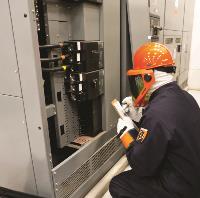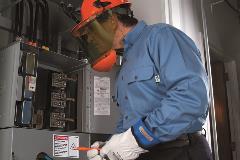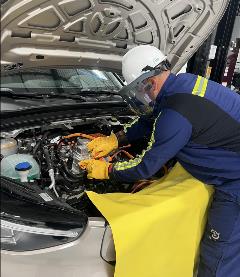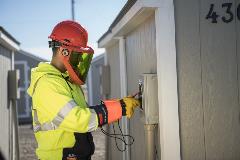Breaking Down OSHA’s Newly Issued Arc Flash Hazard Guidance and What it Means for You

Background
On November 25, 2024, the U.S. Department of Labor’s Occupational Safety and Health Administration (OSHA) released updated personal protective equipment (PPE) guidance for both employers and employees to ensure that the proper arc flash protective clothing and equipment is provided for and worn by anyone working on or near energized equipment. Until this updated OSHA guidance action, more than 600,000 workers did not have the appropriate PPE or equipment to prevent injury from deadly arc flash hazards, despite industry standards such as the National Fire Protection Association (NFPA) 70E: Standard for Electrical Safety in the Workplace.
 This action is OSHA’s first arc flash guidance update in almost 20 years. It consists of four parts, including a detailed document for employers and three one-page documents for workers. The new guidance was primarily issued to address the two leading causes of arc flash injuries and fatalities in the U.S. today:
This action is OSHA’s first arc flash guidance update in almost 20 years. It consists of four parts, including a detailed document for employers and three one-page documents for workers. The new guidance was primarily issued to address the two leading causes of arc flash injuries and fatalities in the U.S. today:
- Claiming work is de-energized which does not qualify (most work fails the standard) and thus having no arc rated clothing or other PPE - De-energized is not the same as Lockout Tagout/Electrically Safe Work Condition and as such requires an energized work permit and arc rated PPE. Not wearing PPE while working on equipment believed to be de-energized is the #2 leading cause of arc flash injuries and fatalities in the U.S. today.
- Choosing to work energized when voltage is low (120/208, 277) despite the lack of justification and not wearing PPE because of the common and dangerous myth that low voltage isn’t hazardous - Energized work typically requires an energized work permit and appropriate PPE where indicated by table 150.3(C) in NFPA 70E or an incident energy study indicating an arc hazard of 1.2+ cals.
The guidance makes it clear that low voltage, including 120/208 volts, can sustain arc flash, produce molten metal, ignite flammable clothing, and cause severe or fatal injury. All energized work over 50 volts requires an energized work permit and almost all work requires PPE including arc rated clothing. OSHA further notes that the steps to de-energize are energized work, as are all the steps to re-energize, and as such require PPE including arc rated clothing.
What is the Reason for the Update?
 Despite having PPE and safety standards in place to enforce protection, injuries and fatalities among commercial and industrial electricians continue to occur at an alarming rate because hundreds of thousands of electricians continue to work energized without work permits and the necessary PPE to ensure safe work and good outcomes if an incident occurs.
Despite having PPE and safety standards in place to enforce protection, injuries and fatalities among commercial and industrial electricians continue to occur at an alarming rate because hundreds of thousands of electricians continue to work energized without work permits and the necessary PPE to ensure safe work and good outcomes if an incident occurs.
Electrical workers are essential to infrastructure improvements and maintenance and brave dangerous conditions every day to fortify our power grid and secure a sustainable future. Electric arc hazards are dangerous, and workers’ safety should not be overlooked in the process of electrifying America. OSHA’s guidance update was imperative to clarify requirements and improve safety now.
 Moreover, as the U.S. continues to invest in large-scale projects such as electric vehicle and direct current (DC) chargers, employers will continue to hire workers with limited training and experience against arc flash hazards. The timing of OSHA’s important action better prepares these employers and their new employees to improve workplace safety and prevent avoidable injuries.
Moreover, as the U.S. continues to invest in large-scale projects such as electric vehicle and direct current (DC) chargers, employers will continue to hire workers with limited training and experience against arc flash hazards. The timing of OSHA’s important action better prepares these employers and their new employees to improve workplace safety and prevent avoidable injuries.
Who is Affected by this New Arc Flash Safety Guidance?
In addition to commercial, industrial, and residential electricians, the guidance also applies to operators, maintenance, and other personnel who work on or near exposed energized electrical parts and is in immediate effect.
Where Can I Find the Updated OSHA Guidance?
The new OSHA Arc Flash Safety Guidance can be accessed on OSHA’s website here.
How Can Saf-T-Gard Help?
 As a leading manufacturer and distributor of rubber insulating products, arc flash safety clothing and kits, grounding equipment, and testing services, Saf-T-Gard is dedicated to aiding businesses where worker safety and protection from electrical current are critically important. Now in its fifth decade of operations, the Saf-T-Gard® Voltgard® Electrical Safety Division serves thousands of customers in nearly every industry, including electric utilities, electrical contractors, telephone and telecommunications companies, cable television operators, auto manufacturers, automobile service and repair shops, public transportation, and industrial facilities.
As a leading manufacturer and distributor of rubber insulating products, arc flash safety clothing and kits, grounding equipment, and testing services, Saf-T-Gard is dedicated to aiding businesses where worker safety and protection from electrical current are critically important. Now in its fifth decade of operations, the Saf-T-Gard® Voltgard® Electrical Safety Division serves thousands of customers in nearly every industry, including electric utilities, electrical contractors, telephone and telecommunications companies, cable television operators, auto manufacturers, automobile service and repair shops, public transportation, and industrial facilities.
Saf-T-Gard is uniquely qualified to keep your electrical workers safe while meeting all applicable industry standards with our Voltgard® Test Lab, the largest and independent NAIL4PET-accredited test lab for rubber insulating products in the U.S. The Voltgard® Test Lab provides full-service testing and recertification of rubber gloves, and for utilities and high-voltage contractors, Voltgard® also tests rubber insulating sleeves, blankets, line hose, covers, dielectric footwear, jumper cables, grounding sets, plastic guards, hot sticks, matting, hoods, and insulating hand tools.
The Saf-T-Gard and Voltgard® team has more than 100 combined years of safety expertise, focusing on industrial and electrical safety. Our team includes ASTM Voting Members, OSHA 30-hour trained safety professionals, Qualified Safety Sales Professionals (QSSP), and NFPA 70E trained safety professionals. The expertise and experience of our team can be an extension of your team when you partner with Saf-T-Gard on your company’s safety program.

